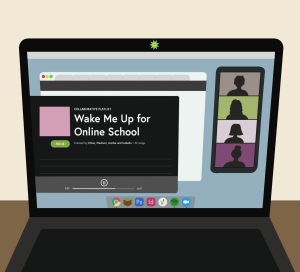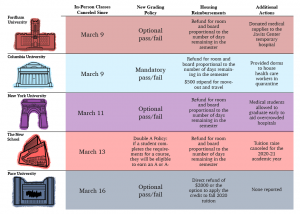New York City Delays the Start of Public Schools
To allow more time for planning, the new start date was pushed back and now students will enter on a rolling basis
Ajay_Suresh Via Flickr
The opening of LaGuardia High School, like all other New York City schools, will be delayed by 10 days to give teachers and principals sufficient time to fine-tune safety protocols. The opening date has now been pushed back further to Oct. 1.
September 18, 2020
Update: As of Sept. 18, NYC schools will begin phased-out openings. Students in pre-K and advanced special needs classes will return on Sept. 21, followed by elementary school students on Sept. 29 and middle and high school students on Oct. 1.
New York City is the only major school district in the U.S. to move forward with in-person classes. However, a New York City teachers’ union is criticizing Mayor Bill de Blasio about his reopening plans. On Sept. 1, the once carefully selected Sept. 10 start date was pushed back to Sept. 21 to allow more time for teachers and principals to better plan for an unprecedented start to the school year.
“It’s frustrating that this announcement was so last minute,” Frankie Rutherford, a senior at LaGuardia High School, just around the corner from Fordham College at Lincoln Center, said. “They had all summer … to plan the best way to do online learning and in-person learning … there are thousands, if not millions, of people affected by schools starting (for food, child care, mental health, etc.) and this last minute pushback feels like poor planning.”
The delay was intended to provide teachers and principals with more time to adjust policies and solidify safety protocols. After threatening to strike, Michael Mulgrew, the head of the United Federation of Teachers in New York City, came to an agreement with de Blasio on the night of Sept. 1 that more safety protocols were needed before schools opened.
As part of the agreement reached between the union and the city, random testing will begin in October. According to de Blasio, between 10 and 20% of the student and staff population will be tested each month. Children whose parents do not consent to testing will not be allowed to attend classes in person.
With the 10-day delay in place, Mulgrew declared that “the New York City public schools system has the most aggressive policies and safeguards of any school system in America.”
“I feel that the push back was warranted given the overall atmosphere of uncertainty.” Kristen Morris, NYC public school teacher
Rutherford, who will be taking online classes four days a week and going to school just one day a week, said she is eager to return to her friends and learn in person, but understands that the delay may “decrease the risk of transmission,” providing a better chance of having in-person classes continue throughout the year.
Nurses have been hired for every public school, ventilation systems have been upgraded in classrooms and personal protective equipment will be distributed. Classrooms will be at one-third of their regular capacity, and windows will be open year-round, no matter the weather, to increase airflow.
While public health experts generally agree that schools can safely reopen with adequate testing and strict safety regulations, concerns still exist regarding staffing for online and in-person teaching.
Teachers have expressed confusion about the testing policy, how ventilation systems will function in aging schools and how many students will actually be attending classes in person.
Teachers will report to school as scheduled to begin online teaching on Sept. 16 and will review protocols with their students virtually.
“I feel that the push back was warranted given the overall atmosphere of uncertainty,” Kristen Morris, an 11th and 12th grade teacher in District 75, said. “The Department of Education has no busing in place – I don’t know how they would get the students in by the tenth.”
Morris has elected to teach in person despite personal health issues. “I just miss being in a classroom, working hands-on with students,” she elaborated. “I make sure to read the classics with my students … This would be largely impossible to do remotely. I love to teach Macbeth – the students feed off of a teacher’s enthusiasm. Remote learning hampers this process.”
Despite the many unanswered questions, de Blasio has emphasized that the district’s mostly low-income Black and Latino students need in-person classes, a claim which is widely supported by education experts, due to on-average lower participation rates by Black and Latino students in online classes from a lack of access to virtual class resources.
De Blasio promised that “there’s a lot we’re going to do right now but the big question is going forward: how do you create a city where these disparities don’t exist?”
Of the 1.1 million students in the school district, about 750,000 are low-income, 200,000 have disabilities and 114,000 are homeless. These demographics are not well-served by remote learning as they may not have access to computers, Wi-Fi and specialized programming.
“My current prediction is that schools will close soon after opening due to (an outbreak), so if this pushback prevents that and allows me to be inside my high school during my senior year safely, then I support it.” Frankie Rutherford, LaGuardia High School senior
Data strongly suggests that low-income neighborhoods in New York City have been hit especially hard by the coronavirus. Furthermore, in 2020, roughly 300,000 New York City students did not have sufficient access to the internet or computers. When schools first closed in March, some students did not receive the devices they requested through the Department of Education. Another obstacle for households with multiple students is finding the space, time and sufficient devices for all to engage in online classes. In July, de Blasio announced a plan to spend $157 million to expand broadband access across the city, hoping to aid in closing the “digital divide.”
“My current prediction is that schools will close soon after opening due to (an outbreak), so if this pushback prevents that and allows me to be inside my high school during my senior year safely, then I support it,” Rutherford said.
Morris holds a similar sentiment, saying, “I think the pushback is necessary. I think we need to figure out the landscape first … I cannot wait for things to approach normal again … I would love to be back in front of a full classroom again, exploring literature with my students.”
Rutherford said that she has faith in her classmates’ ability to understand the risk that going back to school poses and take precautions seriously because of this.
However, she added that she “can’t imagine a situation where everyone follows the rules.” Part of her fear going back is knowing that some kids won’t be able to control themselves from breaking the protectionary protocols.
“We’re all teenagers and often think we’re invincible … but I think that most of my classmates understand the danger that going back to school poses and will demonstrate that knowledge in their behavior — especially because we were living in the epicenter of the virus for so long,” Rutherford said.















